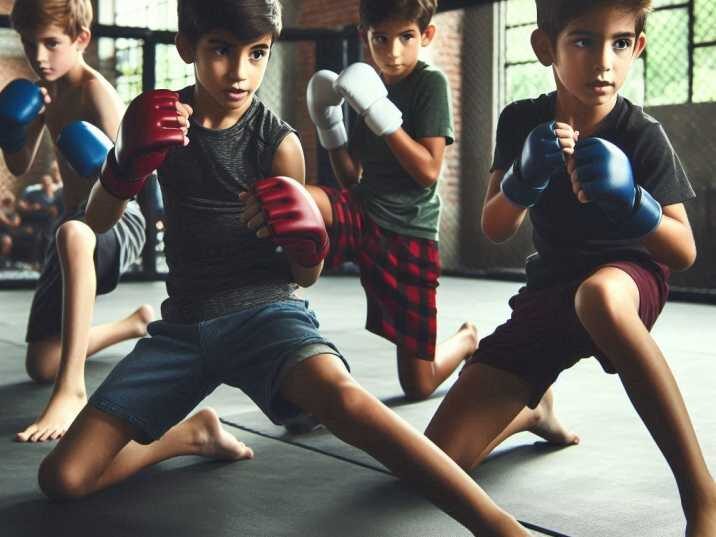Mixed Martial Arts (MMA) training is a type of martial arts practice that combines techniques from various fighting styles like boxing, wrestling, jiu-jitsu, karate, and more. It focuses on teaching self-defense, discipline, and fitness. Mixed Martial Arts training is not only a popular sport but also a fantastic way to develop a range of physical and mental skills. The training involves a mix of punches, kicks, grappling, and ground-fighting techniques. This means learning to defend yourself both while standing up and on the ground.

Introduction to Mixed Martial Arts (MMA)
Table of Contents
Mixed Martial Arts (MMA) is a full-contact combat sport that allows a wide variety of fighting techniques from different martial arts traditions. It involves both striking and grappling techniques, which can be performed either standing or on the ground. Mixed Martial Arts training has gained popularity worldwide and is not only seen as a sport but also as an effective method for physical fitness, self-defense, and character development.
Why is Mixed Martial Arts Training Important?
MMA training is important because it provides a comprehensive workout that strengthens the entire body. It also helps develop important life skills such as concentration, self-discipline, and confidence. For children, Mixed Martial Arts trainingcan improve focus in school and other activities because it teaches them how to concentrate, control their emotions, and make quick decisions under pressure.
The Benefits of Mixed Martial Arts Training
Improved Focus and Discipline
MMA training requires intense concentration, helping both children and adults enhance their focus in everyday tasks, such as schoolwork or job responsibilities. The structured nature of MMA instills discipline, which can lead to better behavior, improved grades, and more thoughtful decision-making. This discipline often translates into various aspects of life, fostering a strong sense of responsibility and perseverance.
Physical Fitness and Strength
MMA is a comprehensive workout that combines cardio, strength training, and flexibility exercises, making it highly effective for building muscle, burning fat, and enhancing overall cardiovascular health. Typical training sessions include exercises like running, jumping, and bodyweight workouts, which improve endurance, agility, and strength. This makes MMA an excellent choice for anyone looking to achieve a high level of fitness.
Self-Defense Skills
A major benefit of Mixed Martial Arts training is learning self-defense techniques that are practical in real-life situations. These skills, such as striking and grappling, provide individuals with the ability to protect themselves in dangerous scenarios, boosting their confidence and sense of security. Understanding self-defense not only builds physical capability but also mental resilience and quick decision-making.
Confidence and Self-Esteem
As students progress in MMA, they learn new skills and overcome challenging techniques, which significantly boosts their self-esteem and confidence. Achieving these milestones provides a sense of accomplishment and encourages a positive self-image. This newfound confidence often extends beyond the gym, positively impacting social interactions and personal challenges.
Stress Relief and Mental Health Benefits
Engaging in Mixed Martial Arts training offers a constructive outlet for stress and anxiety. The rigorous physical activity releases endorphins, the body’s natural mood enhancers, which help reduce feelings of depression and anxiety. Additionally, the intense focus required during training helps clear the mind, providing mental clarity and a sense of calm.
Improved Coordination and Balance
MMA involves various movements that improve coordination and balance, such as kicks, punches, and grappling techniques. These activities require synchronized use of multiple muscle groups, enhancing motor skills and body awareness. This not only helps in the sport itself but also improves overall physical coordination in everyday activities.
How is Mixed Martial Arts Training Conducted?
Training in a Gym or Dojo
Most MMA training sessions take place in a gym or dojo, led by experienced instructors who ensure a safe and effective learning environment. Training usually starts with a warm-up, which may include activities like jogging, jumping rope, or dynamic stretches to prepare the body for more vigorous exercises. This structured approach helps prevent injuries and improves flexibility and stamina, making participants ready for more intense drills.
Fundamentals of MMA Training
Striking Techniques
Striking is a crucial component of Mixed Martial Arts training, focusing on punches, kicks, elbows, and knee strikes to develop power and accuracy. Techniques from disciplines like boxing, Muay Thai, and kickboxing are practiced to enhance striking skills, which are essential for both offense and defense in a fight. Repeated practice of these strikes helps fighters build muscle memory, improve reaction times, and refine their ability to deliver powerful and precise blows.
Grappling and Ground Fighting
Grappling and ground fighting are fundamental in MMA, involving techniques such as takedowns, throws, and submission holds. These techniques are derived from arts like Brazilian Jiu-Jitsu, wrestling, and judo, which teach fighters how to control an opponent on the ground and execute effective submissions. Mastering these skills is crucial for MMA fighters, as fights often go to the ground, where having a strong grappling game can determine the outcome.
Conditioning Drills
Conditioning drills are vital for building the endurance and strength needed to excel in MMA. These drills include sparring, bag work, and bodyweight exercises such as push-ups, squats, and burpees. Engaging in these activities helps fighters improve their stamina, muscular endurance, and overall physical fitness, enabling them to maintain high performance throughout a match. Conditioning also prepares fighters to handle the physical demands of both striking and grappling with sustained energy and resilience.
Safety Measures in Mixed Martial Arts Training
Protective Gear
In Mixed Martial Arts training, wearing protective gear is essential to minimize the risk of injuries. Participants use equipment like gloves to protect their hands, mouthguards to shield their teeth, shin guards to cover their legs, and headgear to protect against head injuries. This gear is crucial during both striking and grappling sessions to ensure that fighters can train safely while reducing the likelihood of cuts, bruises, and concussions.
Supervised Sparring
Sparring sessions are always conducted under the careful supervision of qualified instructors to maintain a safe training environment. Instructors monitor the intensity and ensure that all participants use the correct techniques. Beginners are often paired with more experienced fighters or fellow beginners to ensure that the training remains controlled and accidents are minimized, allowing them to learn safely and effectively.
Proper Technique Emphasis
Instructors place a strong emphasis on proper technique to prevent injuries during training. Learning the correct form for punches, kicks, and takedowns helps reduce the risk of common injuries such as muscle strains, sprains, and fractures. Proper technique not only enhances a fighter’s effectiveness but also promotes long-term health by minimizing wear and tear on the body. This foundational knowledge is key to ensuring safety and longevity in the sport.

Table: Types of Martial Arts Techniques in MMA Training
| Martial Art | Techniques Taught | Benefits |
|---|---|---|
| Boxing | Punches, footwork, defense | Improved hand-eye coordination, reflexes |
| Muay Thai | Kicks, elbows, knees, clinching | Powerful strikes, flexibility, close-combat skills |
| Brazilian Jiu-Jitsu | Takedowns, submissions, ground control | Self-defense, leverage, grappling skills |
| Wrestling | Takedowns, pins, escapes | Strength, endurance, balance |
| Judo | Throws, joint locks | Balance, coordination, joint manipulation |
| Kickboxing | Kicks, punches, combinations | Cardio fitness, agility, speed |
Conclusion:
Mixed Martial Arts training is not just about fighting; it’s about building a stronger body and a sharper mind. For kids, it’s an excellent way to learn discipline, improve focus, and gain confidence. For adults, it offers a comprehensive workout and a way to relieve stress. Mixed Martial Arts training brings together the best of various martial arts styles, providing a well-rounded and effective training regimen that is both fun and challenging. Whether you want to learn self-defense, get fit, or develop mental toughness, MMA offers something for everyone.
FAQs About Mixed Martial Arts Training
- What age is best to start Mixed Martial Arts training?
- Kids can start Mixed Martial Arts training as young as 5-7 years old. It’s important to find a program tailored for children that focuses on safety and basic techniques.
- Is MMA training safe for beginners?
- Yes, with proper supervision and the use of protective gear, Mixed Martial Arts training is safe for beginners. Most gyms emphasize learning techniques correctly to avoid injuries.
- How often should I train in MMA to see results?
- For beginners, training 2-3 times a week is ideal. As you progress, you can increase the frequency to 4-5 times a week for better results.
- Do I need to be in shape before starting MMA training?
- No, you do not need to be in shape to start Mixed Martial Arts training. The training itself will help you get fit over time.
- Can Mixed Martial Arts help with weight loss?
- Yes, Mixed Martial Arts training is an excellent workout that burns calories, builds muscle, and boosts metabolism, all of which can aid in weight loss.


